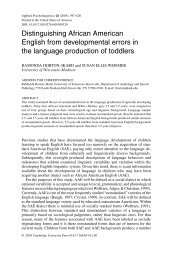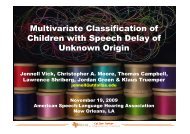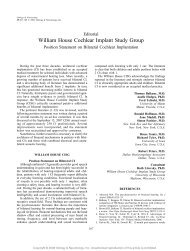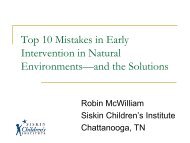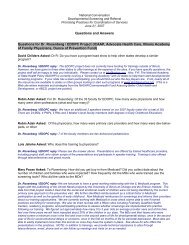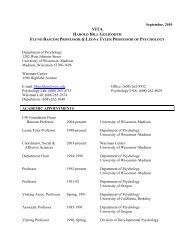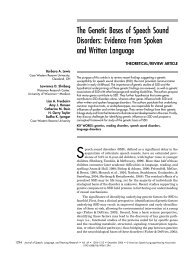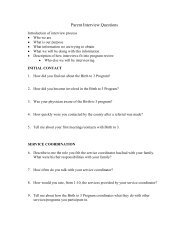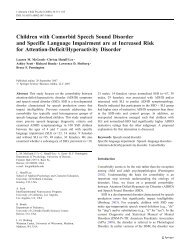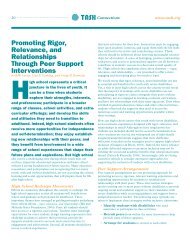Music and Language: A Developmental Comparison - Waisman ...
Music and Language: A Developmental Comparison - Waisman ...
Music and Language: A Developmental Comparison - Waisman ...
You also want an ePaper? Increase the reach of your titles
YUMPU automatically turns print PDFs into web optimized ePapers that Google loves.
Learning <strong>Music</strong> <strong>and</strong> <strong>Language</strong>293Although the precise learning mechanisms underlying the nonnative tonative shift in speech processing remain unknown, it appears that the statisticaldistributions of speech sounds in the input may play a critical role.Speech sounds that are part of the same category in a given language clustertogether in different ways than speech sounds that are part of differentcategories, <strong>and</strong> this appears to be information that is useable by learners.For example, the shift in vowel processing observed in 6-month-old infantscan be induced in nonhuman animals exposed to vowel distributions akinto those of particular languages, such as English versus Swedish (Kluender,Lotto, Holt, & Bloedel, 1998). Experiments explicitly manipulating thestatistical distributions of consonants have demonstrated that this informationaffects infants’ speech perception (Maye, Werker, & Gerken, 2002).It thus seems likely that the learning process that underlies the Japaneseinfant’s discovery that /r/ <strong>and</strong> /l/ are part of the same category is mediatedby the statistical structure of the sounds of Japanese.Some similar shifts have been observed in the domain of music, on thelevel of scale structures. In many instances, young infants show little to noeffect of Western tonal conventions on their perception of <strong>and</strong> memory formusical stimuli. Before 1 year of age, infants detect changes to a melodyirrespective of whether the new note conforms to the implied harmony ofthe original melody (8-month-olds: Trainor & Trehub, 1992) or to thediatonic context in general (9- to 11-month-olds: Trehub, Cohen, Thorpe,& Morrongiello, 1986). Similarly, 9-month-olds are able to detect deviationsfrom a st<strong>and</strong>ard melody regardless of whether the st<strong>and</strong>ard conformsto Western tonal conventions (Schellenberg & Trehub, 1999). By the timethey start school, however, Western listeners’ responses to stimuli begin toshow influences of typical Western musical structure. Four- to six-year-oldchildren detect changes in a diatonic melody more easily than in anondiatonic melody (Trehub et al., 1986). Similar performance effects ofchanged notes differing by key (at 5 years) <strong>and</strong> harmony (at 7 years) wereshown by Trainor <strong>and</strong> Trehub (1994). With 7- <strong>and</strong> 9-year-olds, pairwisediscrimination is likewise enhanced by the nontonality of at least one of themembers (Wilson, Wales, & Pattison, 1997). Scale structure has its greatesteffect on memory for melody when the stimuli contain repeated notes(Schellenberg & Trehub, 1999). These influences continue to be seenthroughout adulthood (Trainor & Trehub, 1992), though as with children,the effects are most pronounced with redundant melodies (Schellenberg &Trehub, 1999). Available correlational data on distributional properties ofWestern music (Budge, 1943; Krumhansl, 1990) indicates that statisticalinduction is a plausible mechanism for this kind of learning, as in the caseof phonemes. Notes <strong>and</strong> chords that are considered the strongest fit withinmany Western musical contexts-at the top of Krumhansl’s tonal hierarchytendto occur in music more often than other, less structurally important



